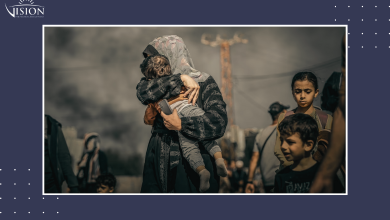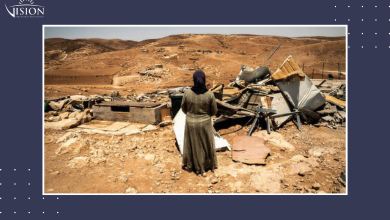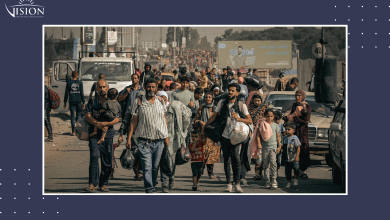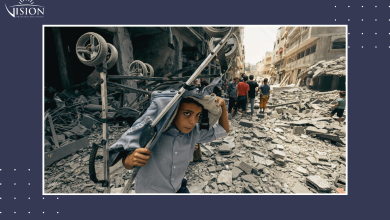Endangered Childhood in Gaza…Under the Shadow of Genocide
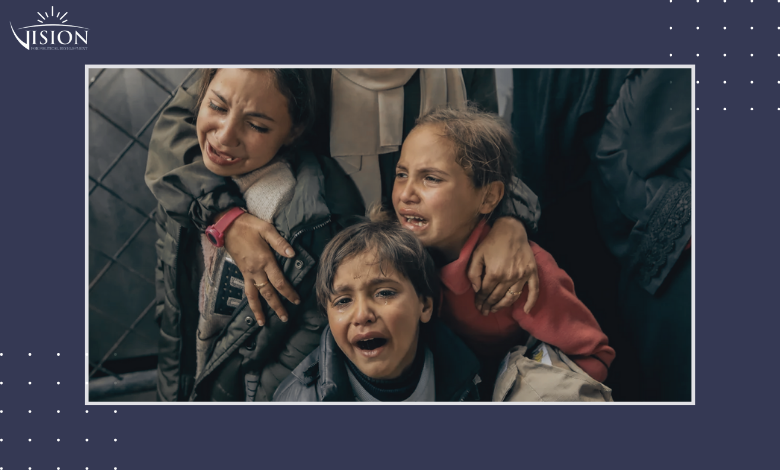
Hedaya Mohammed El Tatar
This report was written during the most recent ceasefire, which we had hoped would mark the end of the tragedy. However, the return of renewed violent attacks on the Gaza Strip have once again pushed all its inhabitants, especially children back to square one, further worsening their already dire humanitarian conditions. The report documents the tragedies and human losses endured by the children of Gaza during a brutal genocide that lasted 471 days—one the region has yet to recover from.
The Gaza Strip witnessed one of the most devastating acts of genocide in modern times. The Israeli siege and bombardment, which lasted for 471 days, destroyed civilian infrastructure and displaced hundreds of thousands of residents, including children who constitute 47% of the population. Due to the ongoing attacks, many families were forced to take shelter in temporary tents under harsh weather conditions. The lack of adequate shelter and humanitarian aid led to the deaths of children from extreme cold and malnutrition.
From the onset of the genocide on October 7, 2023, until the ceasefire agreement on January 19, 2025, the Zionist killing machine brutally killed 17,861 children in the Gaza Strip. Among them were 214 newborns, who were born and martyred during the genocide, and 808 children who were killed before reaching their first birthday. These deaths occurred during massacres carried out by the Israeli occupation against Palestinian families, which totalled 9,268 massacres (Government Media Office, January 2025, Press Release No. 734).
Children were also executed by firing squads, as in the case of Islam Salouha and Saeed Sheikha, who were shot near Al-Shifa Hospital in March 2024. According to the Jewish-American orthopaedic surgeon Dr. Mark Perlmutter, in testimony to CBS News, the Israeli army deliberately targeted and shot children in Gaza.
Many infants also lost their lives due to the Israeli military’s targeting of paediatric hospitals and the disabling of their specialized units through the destruction of power generators and oxygen plants, as happened in Kamal Adwan Hospital in northern Gaza. Additionally, the dire healthcare conditions for infants worsened due to a severe shortage of medications and the breakdown of critical medical equipment.
The Israeli occupation did not stop at killing children with bullets and missile strikes—it further caused the deaths of 44 children through malnutrition and severe food shortages, as part of its starvation policy against Palestinians in the Gaza Strip. By targeting their means of survival, blocking food supply trucks, and destroying agricultural lands, Israel exacerbated the humanitarian crisis.
UN Deputy Secretary-General Amina Mohammed stated that nearly 19,000 children were admitted to hospitals due to acute malnutrition in the four months leading up to December 2024. Meanwhile, the Government Media Office reported that 3,500 children were at risk of death from malnutrition and food scarcity, as only minimal amounts of food aid entered the Strip—far from enough to meet the needs of Gaza’s children (Government Media Office, January 2025, Press Release No. 734).
The Israeli occupation had agreed to allow humanitarian aid trucks under the humanitarian annexure of the ceasefire agreement with the Palestinian resistance, announced on January 9th, with Qatari and Egyptian mediation and U.S. support. The agreement also included the entry of 60,000 mobile homes (caravans) and 200,000 tents. However, Israel failed to uphold its commitments, leading to the death of 13 children due to extreme cold in the displacement camps, as their bodies froze from the cold and lack of adequate clothing.
In addition to the systematic killing of children, thousands suffered severe injuries. Many sustained extensive burns, some reaching third and fourth degrees, while others had limbs amputated or lost their hearing and sight. Israeli attacks also caused serious injuries to the brain, spinal cord, and nervous system, resulting in permanent disabilities and loss of mobility or cognitive function.
According to estimates by the United Nations Children’s Fund (UNICEF) and data analysis conducted in collaboration with the Palestinian Ministry of Health, around 25,000 children were injured during the Israeli genocide in Gaza. Among them were hundreds of critical cases caused by the use of lethal weapons against unarmed civilians. Several UN agencies, particularly UNICEF, described what is happening in Gaza as a “war on children,” referring to the direct targeting and the lifelong catastrophic consequences that these children will endure.
Medical reports cited by The Guardian confirmed that shrapnel from Israeli shelling caused severe injuries to children, many of which required amputations. Since the outbreak of the genocide on October 7, 2023, a significant number of children have become disabled—reaching approximately 800 Palestinian children, accounting for 18% of total amputation cases recorded by the Health Information Unit of the Ministry of Health in the Gaza Strip.
The Israeli occupation further intensifies the suffering of children who survived near-death experiences by blocking the entry of life-saving medications and medical supplies, and by destroying hospitals—leaving these children with little chance of survival. This risks creating an entire generation living with physical and mental disabilities, especially as 25% of the injured require long-term rehabilitation, according to the World Health Organization (WHO).
Illegal Detention, Humiliation, and Psychological Abuse of Children
The crimes of the Israeli occupation against children did not stop at killing and injuring them—they extended to the unwarranted arrests of dozens under harsh and inhumane conditions, according to testimonies from released children. These children were left exposed to the cold without clothing or wearing extremely light clothes that offered no protection from the freezing temperatures. Cold water was poured over their heads, and they were deprived of food and water for five consecutive days, receiving only a few drops. In addition, they were subjected to continuous beatings, insults, and degrading verbal abuse that leaves deep psychological impact and may affect their lives and futures.
In a testimony from Shadi, a 14-year-old boy from Jabalia refugee camp in northern Gaza, who was arrested along with his father and brother from Al-Shifa Medical Hospital, he recounted that his father was beaten in front of him, his mother was insulted, and he was ordered to spit in his father’s face while his father was tied up. When he refused, he was beaten, and his hands were tied with a rope to a tank. As the tank moved, he had to run behind it, while the soldiers laughed at him and fired bullets between his feet.
Thousands of Children Orphaned in the Gaza Strip
The Israeli genocide does not stop at killing Palestinian children in Gaza or leaving them with permanent disabilities—it has also deprived a large number of them of one or both parents, forcing them to endure harsh psychological conditions and emotional trauma caused by the loss of a parent or both.
According to the latest statistics from the Government Media Office in Gaza, the Israeli occupation has orphaned 38,495 children, after one or both of them were killed in airstrikes or tank shelling. These same attacks also wiped out 4,889 Palestinian families, leaving behind only a single surviving member—dubbed “the sole survivor” of their family (Government Media Office, January 2025, Press Release No. 734). These newly orphaned children add to the nearly 33,000 orphans who had already lost their parents in previous attacks on the Gaza Strip, according to statistics from the Islamic charity SKT Welfare.
As a result, a new term has been coined to describe the reality of a specific group of children in the Gaza Strip: WCNSF, an acronym for Wounded Child No Surviving Family. It refers to children who have been injured and have no surviving parents. Their number is estimated at 4,884 (Government Media Office, January 2025, Press Release No. 734). These children require special care to help them cope with the loss of their entire families. Responsibility for their care has shifted to the nearest relatives—for example, five-year-old Salah Qazaaer, who lost his parents and siblings, is now under the guardianship of his uncle. Similarly, three-year-old Yazan Tottah, after losing his entire family, now lives with his grandmother and uncle.
These children, now orphaned after losing one or both parents, need someone to care for them, support them financially, and rescue them from poverty and emotional deprivation—especially from the loss of a father, who often provided for and cared for them. In addition to their material needs, they suffer from deep psychological wounds that can lead to chronic anxiety and depression, posing a threat to their well-being unless they are rescued by their extended families or by specialized institutions that care for orphans.
Traditionally, Palestinian society does not accept or allow the custody and care of orphaned children to be transferred to another family or to orphanages—of which there are only a very limited number in Gaza. This stems from a deep belief in Islamic teachings, which emphasize the importance of caring for orphans and showing them compassion. Additionally, keeping the child within the care of their extended family provides more warmth and emotional support than placing them in an orphanage.
As a result, the care of most of the orphaned children left behind by the Israeli genocide in Gaza has been taken on by surviving family members. For example, an orphaned child’s uncle or aunt will often support the widowed mother in caring for her children, working to provide them with shelter, housing, and basic living needs. They also try to ease the emotional pain of losing a father by maintaining a constant, supportive presence in the children’s lives.
Given the dire economic and social conditions, these families need support in caring for the orphaned children—both financially and emotionally—through what is commonly known as orphan sponsorship. This is a widely recognized concept in many communities, where donors—whether individuals or organizations—commit to sponsoring an orphan with regular financial contributions to help provide care and secure the child’s future until they are able to care for themselves.
In response, relief committees in Gaza have taken the initiative to identify and classify these children, prioritizing them for financial sponsorship and psychological and material support to ensure their well-being and protection. They aim to provide financial sponsorship for every child who has lost their father or both parents. However, due to the overwhelming number of families that have lost their primary breadwinners, these organizations decided to revise the system that was in place before the genocide in Gaza.
Instead of sponsoring all orphaned children within each affected family, they introduced a new system; sponsoring one child per family that lost its breadwinner, rather than all of the orphans in that household. This change was necessitated by limited resources and the ongoing blockade.
Psychological Effects of the War
All the suffering endured by children in the Gaza Strip—along with the harsh living conditions, lack of physical and emotional security, constant reminders of Israeli attacks on their homes, the loss of loved ones, and displacement to tents or shelters—has led to a devastating reality: nearly every child in Gaza, from amongst the total estimated at one million, is now in need of mental health services and psychosocial support, according to Jonathan Crickx, UNICEF’s Chief of Communication in Palestine.
Psychological trauma is a process in which individuals experience intense emotions of sadness, stress, terror, and fear, realizing they are unable to cope with distressing events and their aftermath. This leads them to believe that neither they nor their loved ones are safe. Trauma typically results from a sudden, unexpected event that threatens one’s safety, causing deep feelings of sorrow, anxiety, terror, and fear. These invisible wounds can be deeply damaging to a child’s personality if not addressed through consistent and ongoing care until full recovery is achieved.
A study conducted by the UK-based organization “War Child Care” revealed alarming statistics, stating that 96% of children feel that their death is near, 50% said they wish to die, 92% of children do not accept reality, 87% of children showed extreme fear, 79% suffer from nightmares, 77% avoid talking about traumatic events, and 73% display aggressive behaviour.
The study also confirmed that the psychological effects of war on children may persist long after the fighting ends, deeply impacting their daily lives and social relationships. The organization warned that the children’s mental health crisis could develop into a multi-generational trauma, with consequences that may affect the region for decades to come. These findings highlight the urgent need for comprehensive psychological interventions to help Gaza’s children heal from the profound and lasting trauma of war.
Conclusion
The genocide in the Gaza Strip has left a catastrophic reality for the most vulnerable segments of society—namely children of all age groups. The effects of this reality are unlikely to disappear in the foreseeable future, not only due to the psychological trauma but also because the genocide in Gaza continues in various forms—through the ongoing blockade, obstruction of reconstruction efforts, denial of access to medical treatment abroad, and restrictions on the work of humanitarian organizations, especially those focused on children.
With the resumption of direct military aggression by the Israeli occupation on the morning of March 18, the children of Gaza have once again become targets. The first strikes alone resulted in the killing of dozens of children, many others being severely wounded, or losing their family members.
Therefore, it is crucial that the genocide comes to an immediate end, and that Gaza’s accumulated crises are addressed, with timely reconstruction efforts to save an entire generation of Palestinian children. If not struck down by Israel’s bombs, they are at risk of drowning in a cycle of poverty, deprivation, and fragile health.
On the other hand, the sharp rise in the number of orphans amidst a deteriorating economic situation imposes a humanitarian responsibility on anyone capable of helping or sponsoring these children until they become capable of taking care of themselves. Government institutions, particularly the Ministry of Social Development, also bear the responsibility of organizing coordination among aid organizations working in the sector—ensuring the proper documentation of sponsored children and a fair distribution of sponsorships so that no orphan is left behind or denied their rights.


